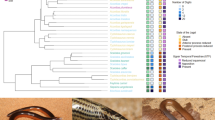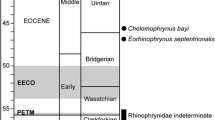Abstract
Dermatonotus muelleri is a forelimbs-head-first burrowing frog that uses its forelimbs for soil removal, and it is the second anuran species known to arch its head downwards at an angle of almost 90° to the longitudinal axis of its body when burrowing. The burrowing behavior of D. muelleri is divided in three stages: head burrowing, body burrowing, and chamber construction. Burrowing in D. muelleri includes construction of a subterranean chamber used for estivation during the dry season. Phylogenetic analysis based on literature survey of burrowing behavior suggested that head-first burrowing behavior has evolved several times in anuran history, forming a convergence complex, and that hindlimbs-first burrowing is a basal behavior.



Similar content being viewed by others
References
Alcala AC (1962) Breeding behavior and early development of frogs of Negros, Philippine islands. Copeia 1962:679–726
AmphibiaWeb (2007) Information on amphibian biology and conservation (web application). http://amphibiaweb.org/. Accessed 11 Jul 2007
Arzabe C, Almeida CC (1996) Life history notes on Leptodactylus troglodytes (Anura, Leptodactylidae) in northeastern Brazil. Amphib-Reptil 18:211–215
Bastos RP, Abe AS (1998) Dormancy in the Brazilian horned toad Ceratophrys aurita (Anura, Leptodactylidae). Ciênc Cult 50:68–70
Brown LE (1978) Subterranean feed by the chorus frog Pseudacris streckeri (Anura: Hylidae). Herpetologica 34:212–216
Brown LE, Crespo EG (2000) Burrowing behavior of the midwife toads Alytes cisternasii and Alytes obstetricans (Anura, Discoglossidae). Alytes 17:101–113
Brown LE, Jackson HO, Brown JR (1972) Burrowing behavior of the chorus frog, Pseudacris streckeri. Herpetologica 28:325–328
Carroll RL (2007) The paleozoic ancestry of salamanders, frogs and caecilians. Zool J Linn Soc 150(Suppl 1):1–140
Cei JM (1980) Amphibians of Argentina. Tipografia Il Sedicesimo, Firenze
Channing A, Broadley DG (2002) A new snout-burrower from the Barotse floodplain (Anura: Hemisotidae: Hemisus). J Herpetol 36:367–372
Crespo EG (1982) Contribuição para o conhecimento da biologia das espécies ibéricas de Alytes obstetricans boscai, Lataste 1879 e A. cisternasii, Boscá1879 (Amphibia, Discoglossidae): morfologia dos adultos e dos girinos. Arq do Museu Bocage 1:255–295
Davies M (1984) Osteology of the myobatrachine frog Arenophryne rotunda Tyler (Anura: Leptodactylidae) and comparisons with other myobatrachine genera. Aust J Zool 32:789–802
Diesmos AC, Brown RM, Alcala AC (2002) New species of narrow-mouthed frog (Amphibia: Anura: Microhylidae; Genus Kaloula) from the mountains of Southern Luzon and Politto Islands, Philippines. Copeia 2002:1037–1051
Duellman WE (1999) Patterns of distribution of amphibians: a global perspective. The Johns Hopkins University Press, Baltimore
Duellman WE, Trueb L (1986) Biology of amphibians. McGraw–Hill Book Company, New York
Emerson SB (1976) Burrowing in frogs. J Morph 149:437–458
Emerson SB (1994) Testing pattern predictions of sexual selection: a frog example. Am Nat 143:848–869
Freitas EFL (2001) Adaptações esqueléticas para a escavação em Leptodactylus fuscus e Physalaemus nattereri (Anura, Leptodactylidae). MSc Thesis, UNESP, Botucatu
Frost DR, Grant T, Faivovich J, Bain RH, Haas A, Haddad CFB, De Sa RO, Channing A, Wilkinson M, Donnellan SC, Raxworthy CJ, Campbell JA, Blotto BL, Moler P, Drewes RC, Nussbaum RA, Lynch JD, Green DM, Wheeler WC (2006) The amphibian tree of life. Bull Am Mus Nat Hist 297:1–370
Gans C, Parsons TS (1965) On the origin of the jumping mechanism in frogs. Evolution 20:92–99
Grafe TU, Kaminsky SK, Bitz JH, Lüssow H, Linsenmair KE (2004) Demographic dynamics of the afro-tropical pig-nosed frog, Hemisus marmoratus: effects of climate and predation on survival and recruitment. Oecologia 141:40–46
Haddad CFB, Prado CPA (2005) Reproductive modes in frogs and their unexpected diversity in the Atlantic rainforest of Brazil. Bioscience 55:207–217
Haddad CFB, Sawaya RJ (2000) Reproductive modes of Atlantic forest hylid frogs: a general overview and the description of a new mode. Biotropica 32:862–871
Hanken J, Wake DB (1993) Miniaturization of the body size: organismal consequences and evolutionary significance. Ann Rev Ecol Syst 24:501–519
Henrici AC, Haynes SR (2006) Elkobatrachus brocki, a new pelobatid (Amphibia: Anura) from the Eocene Elko formation of Nevada. Ann Carneg Mus 75:11–35
Hoffman J, Katz U (1989) The ecological significance of burrowing behaviour in the toad (Bufo viridis). Oecologia 81:510–513
Kaminsky SK, Linsenmair KE, Grafe TU (1999) Reproductive timing, nest construction and tadpole guidance in the African pig-nosed frog, Hemisus marmoratus. J Herpetol 33:119–123
Largen MJ (2001) Catalogue of the amphibians of Ethiopia, including a key for their identification. Trop Zool 14:307–402
Laurent RF (1964) Adaptative modifications in frogs of an isolated highland fauna in Central Africa. Evolution 18:458–467
Lehner PN (1998) Handbook of ethological methods, 2nd edn. Cambridge University Press, Cambridge
Littlejohn MJ, Roberts JD, Watson GF, Davies M (1993) Family Myobatrachidae. In: Galsby CG, Ross GJB, Beesley PL (eds) Fauna of Australia. Australian government Publishing Service, Melbourne
Loveridge JP, Withers PC (1981) Metabolism and water balance of active and cocooned African bullfrogs Pyxicephalus adspersus. Physiol Zool 54:203–214
Lutz B (1961) Mating of Hyla faber. Nat Hist 70:73–77
Márquez R (2004) Sapo parteiro ibérico—Alytes cisternasii. In: Carrascal LM, Salvador A (Eds) Enciclopédia Virtual de los Vertebrados Españoles. Museo Nacional de Ciências Naturales, Madrid. http://www.vertebradosibéricos.org/. Accessed 26 Nov 2007
Martins M (1988) Biologia reprodutiva de Leptodactylus fuscus em Boa Vista, Roraima (Amphibia: Anura). Rev Bras Biol 48:969–977
Martins IA (1996) Reproductive biology of Leptodactylus podicipinus (Cope, 1862) (Anura, Leptodactylidae) in the northwest region of the State of São Paulo. MSc Thesis, UNESP, Botucatu
McClanahan L Jr, Shoemaker VH, Ruibal R (1976) Structure and function of the cocoon of a Ceratophryid frog. Copeia 1976:179–185
McDiarmid RW, Foster MS (1987) Cocoon formation in another hylid frog, Smilisca baudinii. J Herpetol 21:352–355
Neill WT (1952) Burrowing habits of Hyla gratiosa. Copeia 1952:196
Nomura F (2003) Ecologia reprodutiva e comportamento de forrageio e escavação de Dermatonotus muelleri (Boettger 1885) (Anura, Microhylidae). MSc Thesis, UNESP, São José do Rio Preto
Orlov N (1997) Breeding behavior and nest construction in a Vietnam frog related to Rana blythi. Copeia 1997:464–465
Packer WC (1963) Dehydration, hydration, and burrowing behavior in Heleioporus eyrei (Gray) (Leptodactylidae). Ecology 44:643–651
Parris MJ (1998) Terrestrial burrowing ecology of newly metamorphosed frogs (Rana pipiens complex). Can J Zool 76:2124–2129
Prado CPA, Uetanabaro M, Haddad CFB (2002) Description of a new reproductive mode in Leptodactylus (Anura, Leptodactylidae), with a review of the reproductive specialization toward terrestriality in the genus. Copeia 2002:1128–1133
Radhakrishnan C, Gopi KC, Palot MJ (2007) Extension of range of distribution of Nasikabatrachus sahyadrensis Biju & Bossuyt (Amphibia: Anura: Nasikabatrachidae) along western ghats, with some insights into its bionomics. Curr Sci 92:213–216
Ruibal R, Hillman S (1981) Cocoon structure and function in the burrowing hylid frog, Pternohyla fodiens. J Herpetol 15:403–408
Ruibal R, Tevis L Jr, Roig V (1969) The terrestrial ecology of Scaphiopus hammondii. Copeia 1969:571–584
Sazima I (1975) Hábitos reprodutivos e fase larvária de Leptodactylus mystacinus e L. sibilatrix (Anura, Leptodactylidae). MSc Thesis, USP, São Paulo
Sinsch U (1988) Seasonal changes in the migratory behaviour of the toad Bufo bufo: direction and magnitude of movements. Oecologia 76:390–398
Swofford DL, Maddison WP (1987) Reconstructing ancestral character states under Wagner parsimony. Math Biosci 87:199:299
Trueb L, Gans C (1983) Feeding specialization of the Mexican burrowing toad, Rhinophrynus dorsalis (Anura: Rhinophrynidae). J Zool 199:189–208
Tucker JK (1995) Early post-transformational growth in the Illinois chorus frog (Pseudacris streckeri illioensis). J Herpetol 29:314–316
Tyler MJ (1989) Australian frogs—a natural history. Cornell University Press, London
Tyler MJ, Davies M (1993) Family Hylidae. In: Galsby CG, Ross GJB, Beesley PL (eds) Fauna of Australia. Australian Government Publishing Service, Melbourne
Wild ER (1995) New genus and species of Amazonian Microhylid frog with a phylogenetic analysis of new world genera. Copeia 1995:837–849
Zweifel RG (2000) Partition of the australopapuan microhylid frog genus Sphenophryne with descriptions of new species. Bull Am Mus Nat Hist 253:1–130
Acknowledgments
We thank F.B. Noll, E. Crespo, E.G. Freitas, C.F.B. Haddad, L.G.G. Silveira, and G.Q. Romero for critical reviews of the manuscript and helpful suggestions. We also thank Carvalho FR for assistance during field work and Vitória Brasil Administration for the logistical support. Research was funded by Coordenação de Aperfeiçoamento de Pessoal de Nível Superior—CAPES, Grant 3300415-3 (F.N.) and Fundação de Amparo à Pesquisa do Estado de São Paulo—FAPESP (Proc. 01/13341-3).
Author information
Authors and Affiliations
Corresponding author
About this article
Cite this article
Nomura, F., Rossa-Feres, D.C. & Langeani, F. Burrowing behavior of Dermatonotus muelleri (Anura, Microhylidae) with reference to the origin of the burrowing behavior of Anura. J Ethol 27, 195–201 (2009). https://doi.org/10.1007/s10164-008-0112-1
Received:
Accepted:
Published:
Issue Date:
DOI: https://doi.org/10.1007/s10164-008-0112-1




